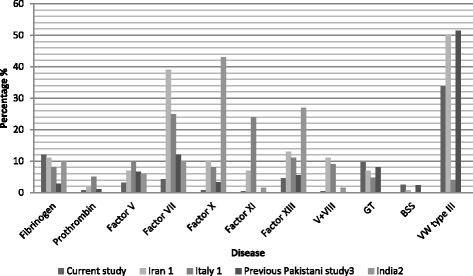Autosomal recessive inherited bleeding disorders in Pakistan: a cross-sectional study from selected regions
- PMID: 28388959
- PMCID: PMC5383974
- DOI: 10.1186/s13023-017-0620-6
Autosomal recessive inherited bleeding disorders in Pakistan: a cross-sectional study from selected regions
Abstract
Background: Autosomal recessive bleeding disorders (ARBDs) include deficiencies of clotting factors I, II, V, VII, X, XI, XIII, vitamin K dependent clotting factors, combined factor V & VIII, Von Willebrand Disease (vWD) type 3, Glanzmann's thrombasthenia (GT) and Bernard-Soulier syndrome. Patients with primary bleeding disorders from all the major provincial capitals of Pakistan were screened for ARBDs. Prothrombin (PT), activated partial thromboplastin time (APTT), bleeding time (BT) and fibrinogen levels were measured. Cases with isolated prolonged APTT were tested for factors VIII and IX using factor assays This was followed by FXI:C level assessment in cases with normal FVIII and FIX levels. vWD was screened in patients with low FVIII levels. Factors II, V and X were tested in patients with simultaneous prolongation of PT and APTT. Peripheral blood film examination and platelet aggregation studies were performed to assess platelet disorders. Urea clot solubility testing was done to detect Factor XIII levels where platelet function tests were normal. Descriptive analysis was done using SPSS version 16.
Results: Of the 429 suspected bleeding disorder patients, 148 (35%) were diagnosed with hemophilia A and 211 (49.1%) patients had ARBDs. 70 patients (16.3%) remained undiagnosed. Out of 211 patients with ARBD; 95 (33.8%) had vWD type 3. Fibrinogen deficiency was found in 34 patients (12%), GT in 27 (9.6%), factor XIII deficiency in 13 (4.6%), factor VII deficiency in 12 (4.3%), factor V deficiency in 9 (3.2%). Eight patients (2.8%) had vitamin K-dependent clotting factor deficiency, Bernard-Soulier syndrome was diagnosed in seven patients (2.5%), factor X deficiency in 2 (0.7%), factor II deficiency in 2 (0.7%), factor XI deficiency and combined factor V and VIII deficiency in 1 (0.4%) patient each.
Conclusion: vWD type 3 was the most common ARBD found in our sample of patients in Pakistan, followed by fibrinogen deficiency and GT in respective order.
Keywords: Autosomal recessive; Bernard–Soulier syndrome; Coagulation factors; Glanzmann’s thrombasthenia; Inherited bleeding disorders; von Willebrand disease type 3.
Figures


Similar articles
-
Congenital bleeding disorders in Karachi, Pakistan.Clin Appl Thromb Hemost. 2011 Nov-Dec;17(6):E131-7. doi: 10.1177/1076029610391650. Epub 2011 Jan 19. Clin Appl Thromb Hemost. 2011. PMID: 21247962
-
Bleeding symptoms in heterozygous carriers of inherited coagulation disorders in southern Iran.Blood Coagul Fibrinolysis. 2011 Jul;22(5):396-401. doi: 10.1097/MBC.0b013e328345f566. Blood Coagul Fibrinolysis. 2011. PMID: 21451397
-
Inherited bleeding disorders.Baillieres Clin Haematol. 1991 Apr;4(2):291-332. doi: 10.1016/s0950-3536(05)80162-3. Baillieres Clin Haematol. 1991. PMID: 1912663 Review.
-
Coagulation Testing in the Core Laboratory.Lab Med. 2017 Nov 8;48(4):295-313. doi: 10.1093/labmed/lmx050. Lab Med. 2017. PMID: 29126301 Review.
-
The spectrum of inherited bleeding disorders in pediatrics.Blood Coagul Fibrinolysis. 2008 Dec;19(8):771-5. doi: 10.1097/MBC.0b013e32830f1b99. Blood Coagul Fibrinolysis. 2008. PMID: 19002043
Cited by
-
Factor XIII deficiency with intracranial haemorrhage.BMJ Case Rep. 2019 Aug 26;12(8):e228682. doi: 10.1136/bcr-2018-228682. BMJ Case Rep. 2019. PMID: 31451452 Free PMC article.
-
Consanguineous Marriage and Its Association With Genetic Disorders in Saudi Arabia: A Review.Cureus. 2024 Feb 9;16(2):e53888. doi: 10.7759/cureus.53888. eCollection 2024 Feb. Cureus. 2024. PMID: 38465157 Free PMC article. Review.
-
Rare bleeding disorders in Pakistan - a call for exploration!Pak J Med Sci. 2023 Jul-Aug;39(4):1221. Pak J Med Sci. 2023. PMID: 37492296 Free PMC article. No abstract available.
-
Glanzmann Thrombasthenia in Pakistani Patients: Identification of 7 Novel Pathogenic Variants in the Fibrinogen Receptor αIIbβ3.Cells. 2023 Jan 4;12(2):213. doi: 10.3390/cells12020213. Cells. 2023. PMID: 36672149 Free PMC article.
References
-
- Bhopal RS, Petherick ES, Wright J, Small N. Potential social, economic and general health benefits of consanguineous marriage: results from the Born in Bradford cohort study. Eur J Public Health. 2014;24(5):862–9. - PubMed
-
- Qidwai W, Syed IA, Khan FM. Prevalence and perceptions about consanguineous marriages among patients presenting to family physicians, in 2001 at a Teaching Hospital in Karachi, Pakistan. Asia Pac Fam Med. 2003;2(1):27–31. doi: 10.1046/j.1444-1683.2003.00047.x. - DOI
Publication types
MeSH terms
LinkOut - more resources
Full Text Sources
Other Literature Sources
Miscellaneous

